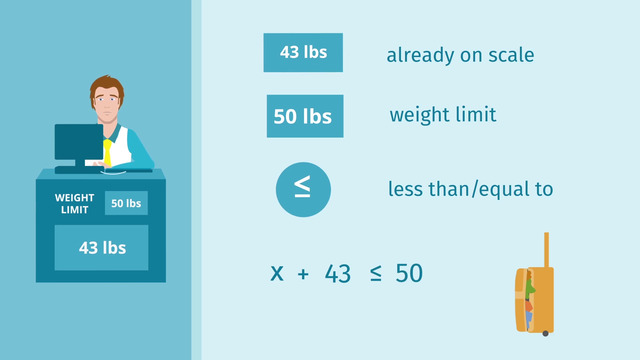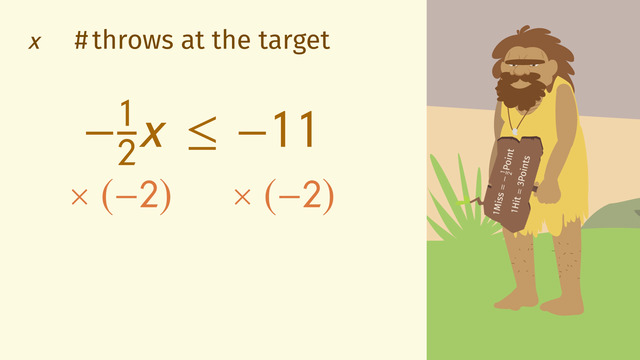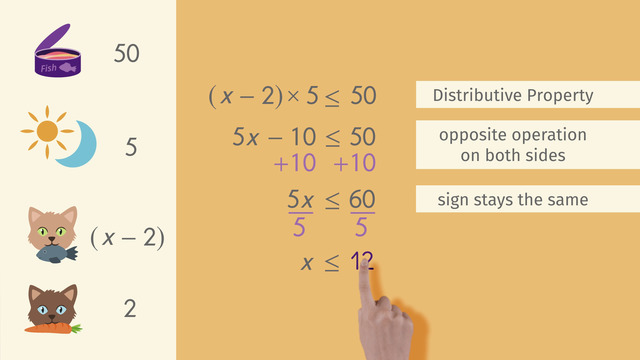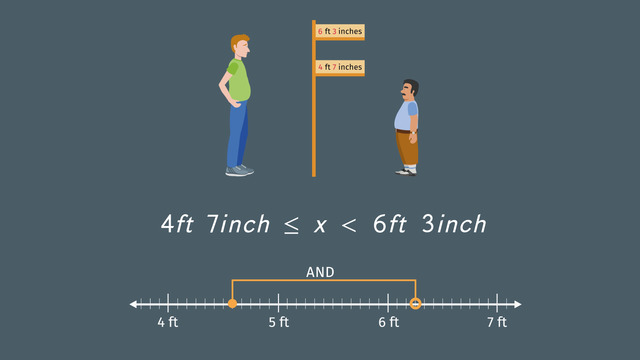Inequalities and Their Graphs
Basics on the topic Inequalities and Their Graphs
Inequalities on a Number Line – Definition
Inequalities on a number line allow us to visually interpret and solve expressions comparing different values. This concept is widely used in various fields such as mathematics, economics, and engineering, helping us understand scenarios like budget constraints, temperature ranges, or any situation where comparison between numbers is required. Understanding properties of inequalities is useful for solving many mathematical problems in the real world.
An inequality on a number line represents a range of values that satisfy a certain condition. It involves symbols like $>$ (greater than), $<$ (less than), $\geq$ (greater than or equal to), and $\leq$ (less than or equal to).
Inequalities on a Number Line – Explanation
Inequalities are graphed on a number line to determine the set of numbers that satisfy the inequality. This is crucial for solving problems involving limits and ranges. The basic elements used in graphing include:
| Symbol | Description | Example |
|---|---|---|
| Open Circle | Indicates that the number is not part of the solution set. | $x > a$ or $x < a$ |
| Closed Circle | Indicates that the number is part of the solution set. | $x \geq a$ or $x \leq a$ |
| Arrow Direction | Points towards the range of numbers that make the inequality true. | Indicates the range of solutions. |
Inequalities on a Number Line – Example
Let’s practice by graphing the inequality $x \leq -2$ on a number line.
Step 1: Identify the Location
- Locate the position where $x = -2$ on the number line.
Step 2: Mark the Point
- Place a closed circle at -2 to indicate that -2 is included in the solution set.
Step 3: Determine the Arrow Direction
Decide which direction to draw the arrow. Since the inequality is $x \leq -2$, the arrow should:
- Point to the left to show that all numbers less than or equal to -2 are included.
Step 4: Describe the Solution Set
Explain the range of numbers that solve the inequality:
- The solution set includes all numbers less than or equal to -2, visually represented by a line extending from -2 to the left indefinitely.
Inequalities on a Number Line – Practice
Using some paper, practice graphing inequalities on number lines.
Inequalities on a Number Line – Summary
Key Learnings from this Text:
- Inequalities on a number line allow for visual comparison of numbers, commonly used in mathematics, economics, and engineering.
- An inequality on a number line shows a range of values meeting a specific condition using symbols like $>$, $<$, $\geq$, and $\leq$.
- Key elements in graphing include open circles (excluding the number) and closed circles (including the number), with arrows indicating the direction of the inequality.
- Practicing graphing inequalities on a number line helps understand and solve problems involving ranges and limits of values.
Inequalities on a Number Line – Frequently Asked Questions
Transcript Inequalities and Their Graphs
This is Timmy. Timmy is the best man at his friend's wedding, but he is running super late. The road he's driving on has a speed limit of 55 miles per hour, which means he should not drive more than 55 miles per hour. This can be represented by an inequality.
Graphing Inequalities: x < y
Let's take a closer look, how to graph this inequality on a number line. The inequality representing speeds less than 55 mph is x < 55. To graph this on the number line, we draw an open circle at 55 mph and an arrow to the left, which shows all speeds less than 55mph.
However, Timmy could also drive at exactly 55 mph, which is the posted speed. The inequality representing speeds 55mph and under is: x is less than or equal to 55mph. We can show this on the number line by using a closed circle at 55 mph instead of an open one, along with the arrow to the left that represents all speeds less than 55mph. Our graph represents the speeds Timmy could drive.
And remember: we use a closed circle because 55mph is included in the inequality, since Timmy could drive at exactly 55mph.
Graphing Inequalities: x > y
Timmy really has to hurry because he's got the wedding cake! Could he go faster than 55mph? Not without breaking the law and risking getting a speeding ticket for driving too fast. We can represent speeds that are faster than 55mph with the inequality x > 55.
The graph of this inequality has an open circle at 55mph and arrow to the right. This graph shows the speeds that would earn Timmy a speeding ticket, since all of them are faster than the posted speed limit.
Graphing Inequalities: x > −y
Now that we understand the main idea of inequality graphs, let's look at another example. This inequality is x > −20.
To graph this, we must include all the numbers greater than, but not equal to, −20. Therefore, we draw an open circle at −20 and an arrow to the right.
If the inequality were x is less than or equal to −20, then we'd need to change two things on the graph.
First, −20 is included in the inequality, so we use a closed circle. Second, this inequality consists of numbers less than or equal to −20, so we use an arrow to the left.
Oh no! Even though Timmy obeyed the speed limit, he was in such a hurry that he didn't notice a bump in the road. Now the cake is ruined!
Inequalities and Their Graphs exercise
-
Describe the process of graphing inequalities.
HintsAny greater than or less than inequality will be graphed with an open circle. This indicates the endpoint value is not included in the solution set.
Any greater than or equal to or less than or equal inequality will be graphed with a closed circle to include the end point value in the solution set.
SolutionRemember, we graph less than inequalities with an open circle and an arrow pointing to the left. Since Timmy must obey the $55$ mph speed limit, he may drive at any speed less than $55$ mph. Our inequality is: $x < 55$.
We graph less than or equal to inequalities with a closed circle and an arrow pointing to the left. Because Timmy can drive exactly $55$ mph, we use a closed circle to include $55$ in our solution. Timmy can also drive slower than $55$ mph, so any value to left of $55$ on the number line will also be included as a part of our solution set. We write this inequality as: $x \leq 55$.
To graph this greater than inequality, we again use an open circle on $55$. This time, however, our arrow will point to the right to include any speed above $55$. The inequality to express this is: $x > 55$.
-
Explain the meaning of the graphs.
HintsRemember, when graphing less than or greater than inequalities, use an open circle on the number line to show that the value is not a solution.
When graphing less than or equal to or greater than or equal to inequalities, use a closed circle on the number line to include the value in the solution set.
SolutionThe graph of $x < 55$ will have an open circle at $55$ and an arrow pointing to the left to include all numbers less than $55$.
The graph of $x > -20$ will have an open circle at $-20$ and arrow pointing to the right to include all numbers greater than $-20$.
The graph of $x \leq -20$ will have a closed circle at $-20$ and an arrow pointing to the left to show that $-20$ as well as all numbers less than $-20$ are in the solution set.
The graph of $x \leq 55$ will have a closed circle at $55$ and an arrow pointing to the left to show that $55$ as well as all numbers less than $55$ are in the solution set.
-
Determine all speeds that will not result in a speeding ticket.
HintsAn open circle on the number line excludes a value from the possible solution set. A closed circle includes the value.
Consider the direction of the arrows. Normally, road signs showing speed limits post a maximum but not a minimum speed.
SolutionOf course Timmy wants to be on time, but he doesn't want to receive a speeding ticket. So the question is, how fast can he drive? The road sign shows $65$ mph, so all speeds less than or equal to $65$ are allowed. The graph that represents this situation is on the right. There are also two other graphs that show speed less than $65$.
HURRY, TIMMY!!!
-
Match the correct inequality with the graph.
HintsRemember, when graphing less than or greater than inequalities, use an open circle to show that the solution set does not include the value.
When graphing less than or equal to or greater than or equal to inequalities, use a closed circle to show that the solution set does include the value.
SolutionTo graph $x \leq 5$ on the number line, use a closed circle to include $5$ in the solution set and an arrow pointing to the left to include all numbers less than $5$.
The inequality $x < -15$ is graphed with an open circle at $-15$ and an arrow pointing to the left to include all numbers less than $-15$, but not $-15$.
We graph $x \geq -10$ with a closed circle at -10 and an arrow to the right.
Lastly, we graph the inequality $x> 18$ with an open circle at 18 and an arrow to the right.
-
Translate the words into a mathematical sentence using inequality signs.
HintsRemember: the open side of the inequality sign points towards the larger quantity. The closed side points towards the smaller quantity.
$3>2$ is a true statement as well as $3 \ge 2$.
SolutionThe greater than and less than symbols help us to determine relative size between different quantities.
- When $x$ is greater (larger) than $y$, we use the $x>y$ sign.
- When $x$ is greater than or equal to $y$, we use the $x \ge y$ sign.
- When $x$ is less (smaller) than $y$, we use the $x <y$ sign.
- When $x$ is less than or equal to $y$, we use the $x \le y$ sign.
-
Describe each situation using inequalities.
HintsKeep in mind that a greater than or less than inequality does not include the value in the solution set. If a ride requires that riders are taller than a particular height, anyone of that exact height would be considered too short to ride.
Different rides require that riders are a certain height or taller or are a certain height or shorter; riders who are the exact height would be able to go on these rides. These are examples of a greater than or equal to or a less than or equal to inequality, so the stated height values would be included in the solution sets.
SolutionFor the Crazy Eight Roller Coaster, the inequality is $x > 4.5$. The Crazy Eight requires that riders are taller than $4.5$ feet, but not $4.5$ feet exactly. Because Kayla is exactly $4.5$ feet tall, she cannot ride the Crazy Eight because the inequality doesn't include $4.5$ in the solution set. Kayla's height is therefore less than the height required for the Crazy Eight.
The inequality for the Endless Loopster can be written as the inequality: $x \geq 4$. We know that Kalya is $4.5$ feet tall and that Tanisha is $4.75$ feet tall. Both girls can ride the Endless Loopster because both girls are taller than $4$ feet.
To ride the Sky High Ferris Wheel, riders have to be shorter than $6.7$ feet tall. We can write this inequality as: $x < 6.7$. Kayla and Tanisha are both shorter than $6.7$ feet tall , so they can ride the Sky High Ferris Wheel.




















Hi Ruth Guenther,
thank you so much for your comment!
You are right. If you drive under the speed limit, you will never get a speeding ticket. We fixed the problem and are happy that you liked the explanation in the video.
Best wishes from sofatutor!
Well explaned Video. A sad end though.
I wanted do ask why it says in problem 5:"Determine ALL speeds that will not result in a speeding ticket."
If I would mark ALL speeds that are under the speedlimit(65mph), or exactly it, then why doesn't it include x<55 and x<56?